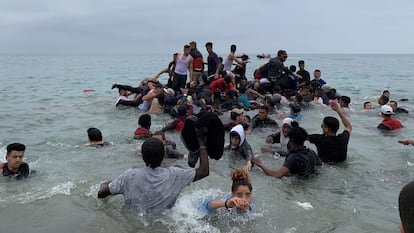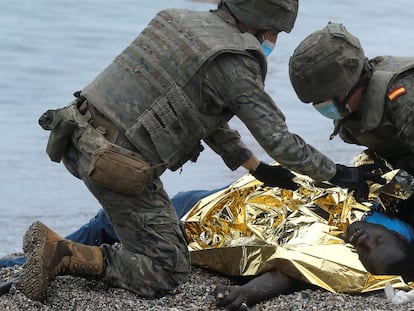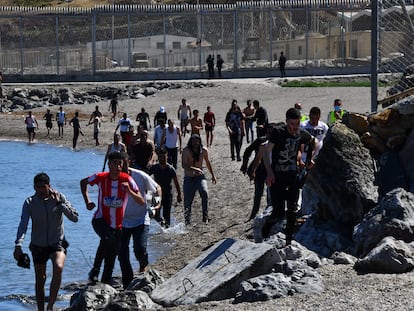Explainer: How did the migrant crisis in Spain’s city of Ceuta occur and what is going to happen now?
Some 8,000 people managed to reach Spanish shores from Morocco this week, many of them minors. This breach of the country’s borders is unprecedented and presents major challenges for authorities


The irregular entry of nearly 8,000 migrants from Morocco into the Spanish North African city of Ceuta on Monday and Tuesday has sparked an unprecedented migratory crisis on the border. Never before has such a large number of immigrants arrived in such a short time.
Spanish prime minister, Pedro Sánchez, canceled a trip to Paris on Tuesday to travel to Ceuta and Spain’s other exclave city, Melilla, where 86 people managed to jump the border fence in the early hours of Tuesday morning. Of the 8,000 people who had arrived in Ceuta since Monday, either swimming or using makeshift flotation devices, nearly half have been sent back to Morocco, according to the Interior Ministry, which has not given more details about the expulsion procedures employed.
The unprecedented crisis in Ceuta has left many unanswered questions, ranging from the reasons why the Moroccan authorities let so many people breach the border – apparently a diplomatic punishment – to the way in which the thousands of people, including hundreds of minors, will now be taken care of.
What is happening in Ceuta? Rumors began to spread in Morocco on Sunday night that the local authorities were taking a lax attitude to border control. As a result, in the early hours of Monday morning hundreds of people approached the jetties that separate the North African country from the Spanish city to cross them by sea or on foot. The Moroccan gendarmerie displayed an “unusual passivity,” according to Spanish security forces.
By Tuesday afternoon, 8,000 immigrants had arrived in Ceuta, most of them Moroccan but also some sub-Saharans. Dozens continued to arrive throughout the day. Most were young men but there were also entire families and around 1,500 minors, some of whom were very young according to the Ceuta government.
What sparked the incident? The apparent motive was Spain’s decision to admit Brahim Gali, 73, into the country for medical treatment while he was suffering from Covid-19. Gali is the founder of the Popular Front for the Liberation of Saguia el-Hamra and Río de Oro (Polisario Front), a liberation movement for the Sahrawi people that is outlawed in the parts of Western Sahara under Moroccan control. He was admitted under a false name to a hospital in the Spanish city of Logroño. This move angered Morocco. But compounding the situation was Donald Trump’s recognition in December of last year of Moroccan sovereignty over Western Sahara. This prompted Rabat to exercise unprecedented pressure on Spain and the European Union so that they “abandoned the comfort zone” of the United Nations over the disputed territory, in the words of Moroccan authorities, and they followed in Trump’s footsteps.

What has been the Spanish government’s position? The government has responded by trying to resolve the crisis, which has sparked widespread alarm within the executive – a coalition of the Socialist Party (PSOE) and junior partner Unidas Podemos. The prime minister held a press conference on Tuesday at which he spoke about the need to defend the “territorial integrity” of Spain. He stepped up the government’s diplomatic activity and in particular focused on the European Union in search of support. Sánchez deployed the army in Ceuta on Monday and made a series of calls on Tuesday, including to Spain’s King Felipe VI and the leader of the main opposition Popular Party (PP) Pablo Casado.
What is Morocco saying? The Moroccan government has kept quiet about what has happened. The only statement from one of the country’s officials so far came from its ambassador in Spain, Karima Benyaich, who said that there “are acts that have consequences and that have to be accepted” before she was recalled for consultations by Rabat.
What will happen to the migrants? The Interior Ministry is focusing on expelling as many as possible as quickly as possible. While Morocco permitted them to cross the border headed to Ceuta, it is also accepting the migrants back into its territory. On Monday and Tuesday, around 4,000 people were sent back to the North African country, according to Interior Ministry sources.
According to news agency Efe, as well as a number of police sources who have spoken to EL PAÍS, these expulsions were, in many cases, carried out without the proper formalities and on a collective basis. The lawyers association in Ceuta has confirmed that its attorneys were only mobilized at 2pm on Tuesday, despite the fact that the expulsions began on Monday. According to sources from the association, the lawyers were called to open cases related to the expulsions in accordance with the parts of the Immigration Law that relate to irregular entry into Spain and guarantee a minimum legal coverage.
The Interior Ministry, however, has until now refused to give details about the procedures being used to expel the migrants and has only clarified that they are “refusals at the border,” a euphemism for irregular expulsions or express deportations.
What will happen to the minors? They should not be returned to Morocco under Spanish law and their interests as minors should take precedence. Interior Ministry Fernando Grande-Marlaska stated on Tuesday that no youngsters had been sent back across the border. Police sources added that if any minor has returned to Morocco, it is because they requested to be let through.
With less than 19 square kilometers of territory, how will Ceuta cope? The Ceuta government and the central government’s delegation in the North African city has set up spaces to deal with the migrants – in particular the minors but also the adults that are still in the city. The approximately 1,500 minors who crossed the breakwater were in a warehouse in Tarajal on Tuesday afternoon. All shelters in the city are completely overwhelmed. Red Cross sources said that there were no figures for the number of people who were assisted on arrival – many of the migrants were exhausted after swimming ashore – nor how many people were sent to hospital. Many sources on the ground spoke about a situation of “mayhem.”
Has this situation ever been seen before? This is the first time that such a large number of migrants has crossed the Spanish borders in an irregular manner. Not even the crisis in the Canary Islands in 2006, nor during the summer of 2018, have so many people arrived all at once. The last record was seen in November 2020, when around 2,200 people came ashore in Arguineguín, in the Canary Islands, over the space of just two days.
With reporting by Francisco Peregil, Carlos E. Cué, Laura J. Varo and Guillermo Abril.
English version by Simon Hunter.









































